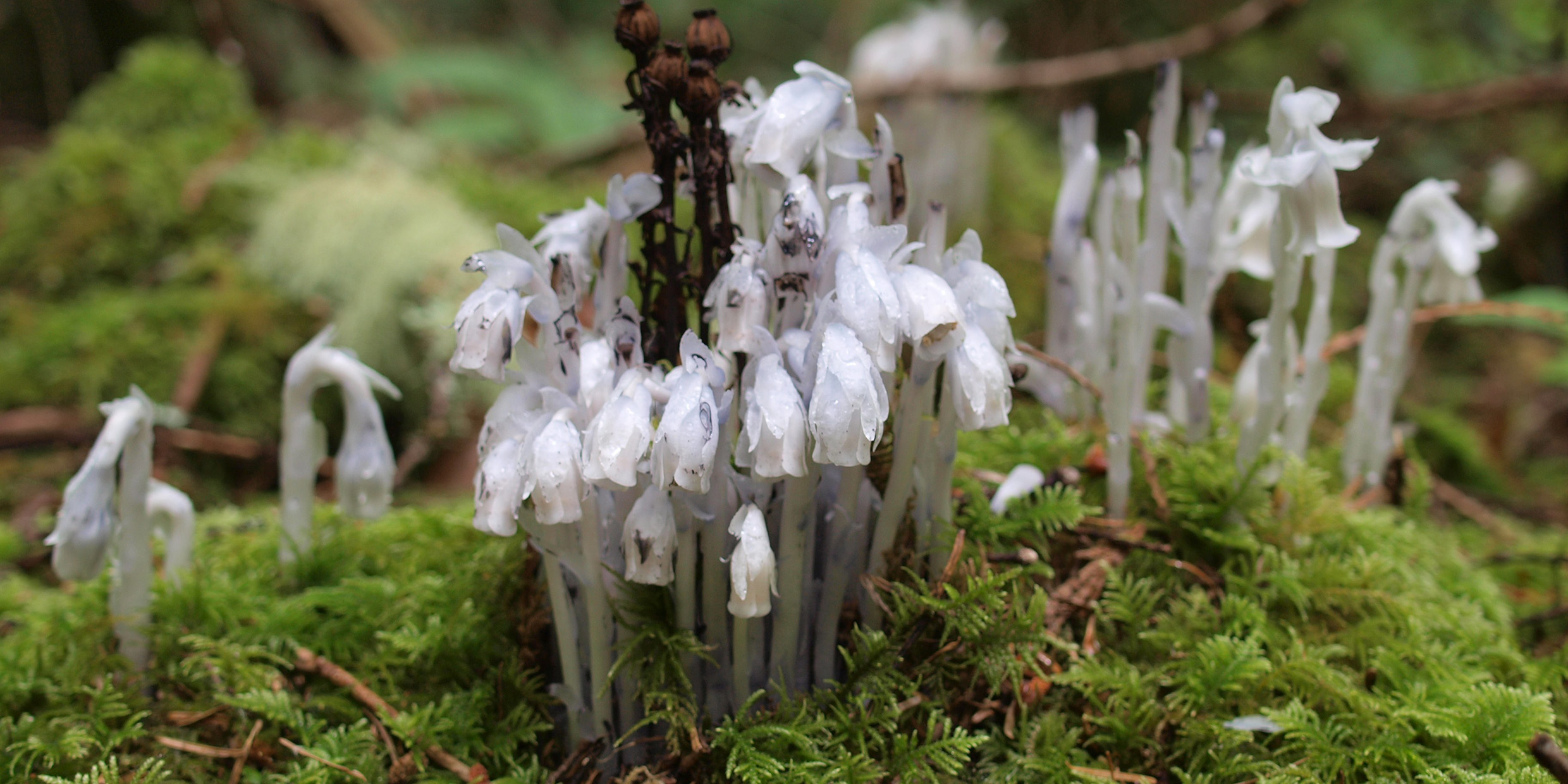Originally published 5 October 1987
It’s been a bumper year for Indian-pipes. I can’t recall another time when I have seen so many. Even as I write, in late September, they are still common in the pine-oak woods, pushing up through the leaf litter on the forest floor, little covens of waxy-white wildflowers, ghostly, bewitching, vaguely demonic.
Corpse-plant, ghost-flower, ice-plant: Other names for Indian-pipe convey that same spooky, cold-as-death impression. No gaudy petals, not a tinge of green: the Indian-pipe simply doesn’t fit our idea of what a wildflower should be. The casual observer might take the plant to be a fungus, some sort of bulb-capped mushroom casting spores on the wind.
But wildflower it is, a true, seed-producing, vascular plant, almost unique among our common plants in that it has no chlorophyll. Colorless in every part, or perhaps with just a hint of pink in the flower head, Indian-pipe lacks the green pigment that enables other wildflowers to absorb energy from sunlight. It must therefore live off food produced by other plants. Like a mushroom, it derives its sustenance from decaying vegetable matter on the forest floor.
Parasite on a parasite
In place of the usual root system, the the Indian-pipe maintains a cozy underground relationship with a fungus. The fungus assists the plant by breaking down organic matter in the soil. In a sense, the Indian-pipe is a parasite on a parasite, twice removed from the light of the sun. It is this independence of sunlight that allows the plant to thrive in the shadows.
These specter-like, parasitical flowers have inspired in their beholders a dark range of sentiments. A typical reaction can be found in Neltje Blanchan’s book on wildflowers from early in this century. From the wraithlike Indian-pipe Blanchan draws a turgid moral tale. The plant, he writes, stands as a branded sinner: “Doubtless its ancestors were industrious, honest creatures, seeking their food in the soil, and digesting it with the help of leaves filled with good green matter [chlorophyll] on which virtuous vegetative life depends; but some ancestral knave elected to live by piracy, to drain the already digested food of its neighbors.”
So far, Blanchan is on the mark. Botanists tell us that Indian-pipe is a member of the wintergreen family of plants, not far removed from the heaths, and therefore a relative of such woodland favorites as rhododendron, azelea, and laurel — sturdy, honest creatures all. How botanists manage to find much in common between the colorless, parasitical Indian-pipes and those glossy-green, flower-bedecked shrubs must seem a mystery, a bit of voodoo taxonomy. But sure enough, all of these plants share certain defining characteristics — radially symmetric flowers, superior ovaries, four or five petals usually fused, fruit a capsule or berry, and so forth — in spite of their superficial dissimilarities.
It is easier to see a likeness between Indian-pipe its close cousins of the woodland floor, the wintergreen and the pipsissewa, but even here the resemblance is like that between a living, breathing human being and a zombie. Indian-pipe has surrendered its color. Its leaves have degenerated into scaly bracts. Says Blanchan: No wonder this backslider hangs its head; no wonder it grows black with shame on being picked, as if its wickedness were only then just discovered.
Something to admire
Neltje Blanchan finds only one thing to admire in Indian-pipe: “When the minute, innumerable seeds begin to form, it proudly raises its head erect, as if conscious that it had performed the one righteous act of its life.”
Thoreau was perhaps more charitable in seeing in the clump of Indian-pipes a gathering a maidens, robed in pure white, nurtured in a dark underground cloister, and now making their entrance into the world of light. Under their white hoods and capes (writes Thoreau) the virtuous sisters strive to conceal their nakedness and tenderness. But soon, exposed to light and air, their virtue is turned black. Thoreau’s image is archaic and overblown, but accurate. Once fertilized, the nodding white flower of the Indian-pipe turns erect and the plant becomes tough and black. The capsule at the top of the mature plant splits down the sides and the seeds are spilt to the wind.
We are apt to smile at the way early nature writers like Thoreau and Blanchan discovered moral lessons among the creatures of the forest floor. But the bizarre biology of Indian-pipe seems to call for the flamboyant metaphor. Its whiteness begs for a generous helping of purple prose. Ghoul, phantom, ectoplasmic spook: These are the words that jump to mind.
The Indian-pipe hardly deserves its reputation as grave-robber and spook. The plant is surely no more or less despicable than any other wildflower parasite — pinesap, beech-drops, broom-rape, or dodder — and considerably prettier than most. In this day when the recycling of waste and the frugal use of energy resources are considered honorable activities, the Indian-pipe cannot be faulted for squeezing a modest living out of the squandered residue of summer.
“In summer, greenness is cheap,” said Thoreau. Plants with chlorophyll can afford to be spendthrifts. The Indian-pipe is one of nature’s ways of pinching pennies.



